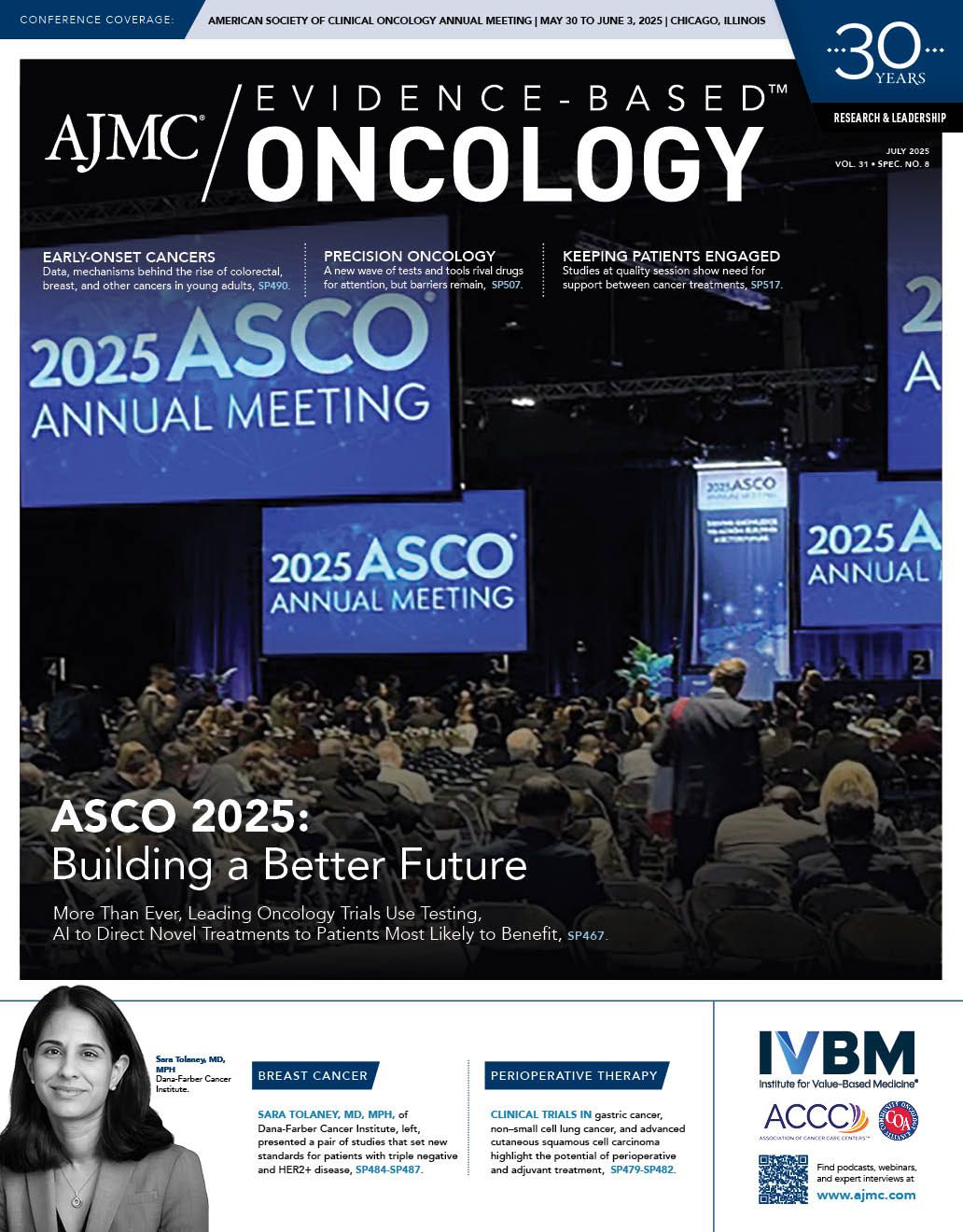- Center on Health Equity & Access
- Clinical
- Health Care Cost
- Health Care Delivery
- Insurance
- Policy
- Technology
- Value-Based Care
Oncology Biosimilars Offer Potential Relief From Financial Burden of Cancer Care
Oncology biosimilars significantly reduce financial toxicity in cancer care, as highlighted in 2 abstracts presented at the 2025 American Society of Clinical Oncology Annual Meeting.
Oncology biosimilars may help alleviate some of the financial toxicity faced by both patients and health care systems due to cancer care, according to 2 abstracts presented at the 2025 American Society of Clinical Oncology Annual Meeting.
Oncology biosimilars significantly reduce financial toxicity in cancer care, as highlighted in 2 abstracts presented at the 2025 American Society of Clinical Oncology Annual Meeting. | Image Credit: Dee Karen - stock.adobe.com

Wide-Ranging Financial Toxicity Highlights Disparities in Cancer Care Costs
Financial toxicity in cancer care presents a significant burden for both patients and health care systems, according to the authors of the abstract, “Quantifying Financial Toxicity in Oncology: A Comprehensive Analysis of Prescription Cost Disparities Using Public Data From 2022.”1 To assess the extent of this burden, they evaluated oncology-related prescription data from the 2022 Medical Expenditure Panel Survey, focusing on antineoplastic and immunologic agents.
More specifically, they assessed cost distributions, payment sources, and financial burden (prescription costs exceeding 20% of annual household income) across various insurance types and demographic factors (age, gender, race, income, and education). Also, the researchers analyzed the impact of geographic factors with Federal Information Processing Standard state codes.
Their analysis included 1379 oncology prescriptions, averaging $1569 (median, $388) per prescription, with a cost range of $19 to $7208. Annual prescription costs varied widely, from $2507 (25th percentile) to $26,857 (75th percentile), with a median of $3561 and a mean of $14,138. Non-prescription medical expenses, including those for hospitalizations and procedures, added a further financial load, with a median of $45,475 and a mean of $47,509; some patients had costs that exceeded $132,396 annually.
Uninsured patients faced the highest average annual costs ($78,439), followed by Medicare patients ($67,979). Although VA/TRICARE patients had moderate annual costs ($56,619), they had higher prescription spending ($16,758). In contrast, Medicaid patients had the lowest total costs ($53,469). When factoring in income, low-income patients faced the greatest financial burden, spending 11.71% of their annual income on prescriptions, compared with 5.89% for middle-income and 2.66% for high-income patients.
In terms of insurance type, private insurance beneficiaries faced the highest average out-of-pocket costs ($5500-$6000), especially among Black and White beneficiaries, followed by Medicare enrollees ($4500-$5000). Conversely, Medicaid beneficiaries incurred lower out-of-pocket costs ($3500-$4000), while uninsured patients had the lowest mean costs ($2500-$3000), likely reflecting limited access to comprehensive treatment.
Demographic analyses showed that female patients endured higher costs for breast and lung cancer treatments. Also, Black and Hispanic patients relied more heavily on Medicaid coverage. Additionally, education level influenced patients' financial burden, with those who received graduate degrees having higher average costs ($4226) than those with a high school education or less ($3707).
Lastly, geographically, the financial burden was highest in the Midwest, moderate in the Northeast, and varied across coastal and Southern states.
Based on their findings, the researchers concluded that significant disparities in financial toxicity exist across insurance types, demographics, and regions. Because of this, they suggested ways to make cancer care more affordable.
“The gap between mean and median costs underscores the disproportionate financial strain faced by some patients,” the authors wrote. “Policy interventions, including expanded insurance coverage, capped out-of-pocket costs, and targeted subsidies, are needed to improve equity and affordability in cancer care.”
Rising Use of Oncology Biosimilars Associated With Lower Cancer Drug Spending
The use of biosimilar versions of reference drugs may help reduce cancer treatment costs, according to the authors of the abstract, “Cost-Effective Cancer Care: The Role of Oncology Biosimilars in Generating Cost Savings.”2
While not designated as directly interchangeable, biosimilars are widely considered reasonable alternatives to their reference drugs. To assess their potential impact, the researchers evaluated the adoption, costs, and savings associated with key oncology biosimilars.
Using publicly available, specialty-agnostic Healthcare Common Procedure Coding System-level utilization and cost data from the Medicare Part B Spending by Drug, the researchers analyzed biosimilar use for 5 reference drugs (bevacizumab, trastuzumab, rituximab, peg-filgrastim, and filgrastim) between 2015 and 2022.
They then modeled 2 spending scenarios for 2022: one in which only the reference drugs were used and another in which the cheaper option, whether reference or biosimilar, was selected for all eligible indications. By comparing these models with actual 2022 Medicare spending, the researchers estimated both generated savings and additional savings opportunities.
Over the 8-year period, each reference drug received multiple biosimilar approvals. As a result, biosimilar use increased from 0% in 2015 to 56.4% in 2022.
The researchers discovered that the introduction of biosimilars was associated with price reductions for both reference drugs and biosimilars. By 2022, all biosimilar prices were lower than those of their respective reference drugs; peg-filgrastim, whose price fell below that of its biosimilars, was the only exception.
In 2022 alone, biosimilar adoption resulted in a 23% spending reduction for Medicare, with an additional 14% savings opportunity identified. Based on these findings, the researchers concluded that oncology biosimilars have already generated significant cost savings for Medicare, with further areas for potential improvement.
“The complex relationship between biosimilar prices and their utilization warrants additional evaluation,” the authors wrote. “Additionally, the effects of biosimilar payment policies, such as those introduced by the Inflation Reduction Act, and the impact of payer-specific product mandates on overall biosimilar adoption need to be further explored.”
References
- Bhimineni C, Modi S, Pokhriyal S, Gillespie B, Leighton J. Quantifying financial toxicity in oncology: a comprehensive analysis of prescription cost disparities using public data from 2022. Presented at: 2025 ASCO Annual Meeting; May 30-June 3; Chicago, IL. Abstract 1612.
- Gilmore J, Indurlal P, Rainey AM, Sabo-Wagner S, Rahman A, Swart S. Cost-effective cancer care: the role of oncology biosimilars in generating cost savings. Presented at: 2025 ASCO Annual Meeting; May 30-June 3; Chicago, IL. Abstract 11033.

Mental Health Care Use After Leaving Medicare Advantage for Traditional Medicare
December 1st 2025Medicare Advantage beneficiaries with mental health diagnoses see more nurse practitioners and fewer internal medicine and emergency medicine specialists after switching to traditional Medicare.
Read More
